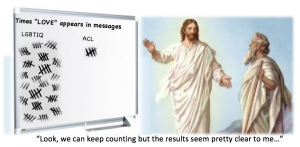It’s Australia’s turn to have the Marriage Equality debate. Rather than allowing a conscience-vote in Parliament, this week the Australian Government has launched a non-binding plebiscite on the definition of marriage, which has lead society and media at large into a free-for-all bun fight. While this is largely a bid for human rights: Changes to the law will allow LGBTIQ+ people to visit their partner in hospital as a legally recognised family member, nominate their partner to be their superannuation beneficiary, leave their partner items in their will without contest from family, etc. it is largely playing out as a perceived attack on religious freedoms. There’s strong opinions on both side of the debate and many ways the debate gets expressed as hate, but here are some of the ways it can playfully be expressed as humour and an invitation to love, particularly from those who don’t think being gay and loved by God are mutually exclusive terms.
The “it was Adam and Eve, not Adam and Steve” shtick has been represented in plugs and seatbelts that won’t join or work properly, denying the God-given dignity to all those who are made in God’s image and the companionship we are called to find with one another. When we are reduced to our nuclear and procreative limits you render all sorts of family-models invisible including those who adopt and foster, those raised by grandparents and aunties and uncles, those who parents divorced – especially where those homes were unstable, those who have problems conceiving… the mechanics don’t matter as much as the desire to give and receive love. If we can dream it, we can live it.
There is much laying claim to biblical texts in support of the case for “the biblical definition marriage”. This rather conveniently skims over things like polygamy and marrying your brother’s wife if he should happen to pass away… lifting text without any socio-political contextualisation, such as 1 Corinthians 7:2 which says: “each man should have his own wife and each woman her own husband” but the first half of that sentence reads “…because of the temptation to sexual immorality,” What matters more, the gender of the parties or the commitment they are called to hold to one another? I don’t have a problem with the call to a higher love, but are we denying that call to others? Many churches would re-marry someone who had been widowed or divorced, they don’t bar the door if you’ve had sex before you are married… if the Church wants to take a strong and clear position on sexual dignity and reverence that’s great – why don’t we speak out as vociferously on paedophiles, porn or sex trafficking? First the log… personally and institutionally who among us is without sin? And while the Church is bringing the wrath, LGBTIQ+ signs and banners at rallies have read: Love is divine, love is for everyone, love is love, love is a terrible thing to hate, no stopping love, marriage is between love and love… wait, whose side are they on again?
Different pages are popping up such as Christians for Marriage Equality that has lovely storytelling, sharing peoples reasons for supporting equality and the Rainbow Revolt page that encourages people to put a rainbow in their own window, property, shop, neighbourhood and take a photo and share it to encourage those feeling defeated by the public discourse as an act of solidarity and support such as this one of lions out the front of the house #gaypride, geddit? …because they’re lions.
How intriguing that rainbows, that have long been seen as symbolic of a promise by God that dark times will end and they will not come again, have become the rallying flag of this movement. This colourful, happy signal isn’t only expressed to be for humans but also a reminder for God who said: “When I bring clouds over the earth, and the bow appears in the clouds, I will remember my covenant between me and you and every living creature—every mortal being… (Gen 9:12-16) Imagine for just a moment that every rainbow borne was someone asking: “What about me?” Linked to the dove and the olive branch the rainbow is a symbol for peace. In the original 8-striped design by Gilbert Baker for the Gay Freedom Day Parade in San Francisco 1978, each strip of colour was assigned meaning: red for life, orange for healing, yellow for sunlight, green for nature, blues for magic/art and serenity, purple for the spirit, and hot pink for sex {suggestive eyebrow wriggle}.
There might be more hope for the world we share in common than we realise if we can focus more on the ways we are alike than those we are different and let hate become love.


1 comment
Well said ❤️❣️